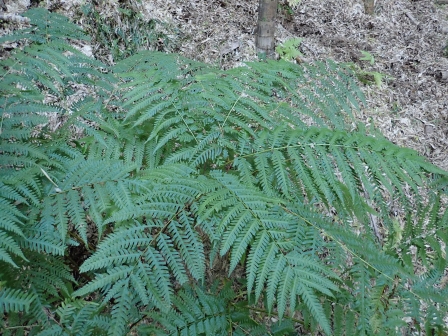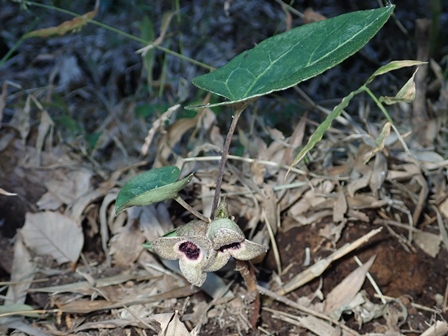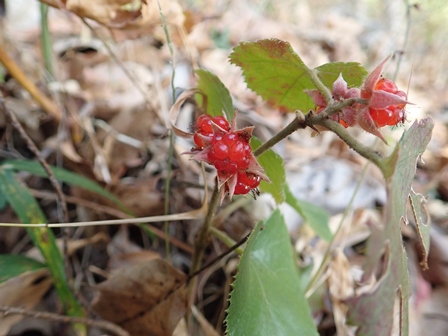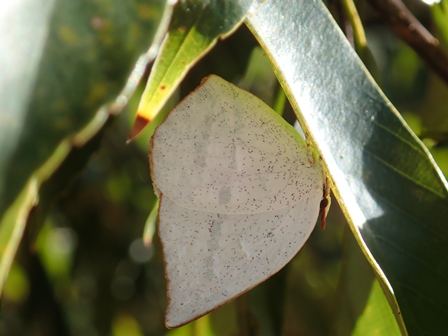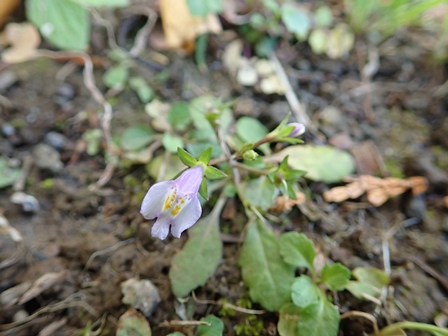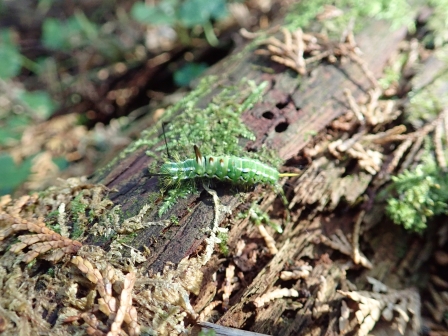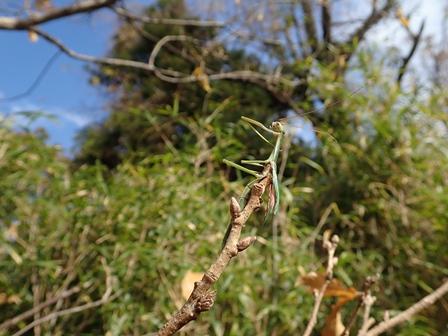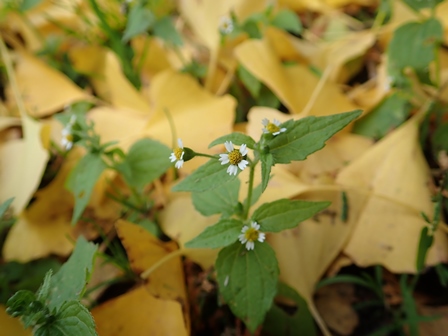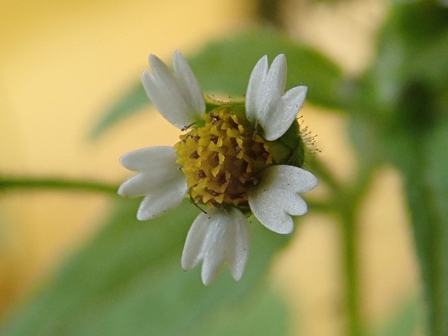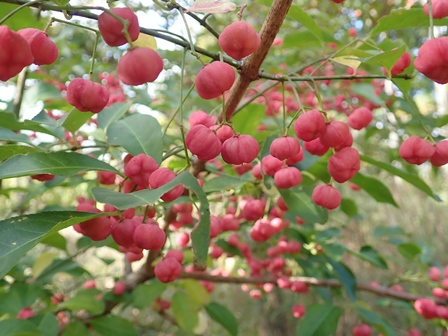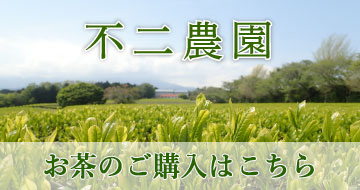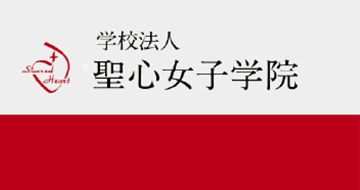フィールド日記
2021.01.05
ナチシダ
竹林にナチシダが見られます。ナチシダは五角形に広がる大型の葉が特徴の暖地性のシダです。静岡県河津町の自生地は1953年にナチシダの自生北限地として国の天然記念物に指定されています。近年では神奈川県などより北の自生地も知られており、不二聖心も実際の北限に近い自生地といえるかもしれません。
I found a "Nachishida (ナチシダ)" in a bamboo forest. "Nachishida (ナチシダ)" is a fern that has unique pentagon-shaped leaves and grows in warm climate. Their habitat, Kawazu, Shizuoka was designated as a national nature treasure in 1953 because it is regarded as "the northern limit of natural growth". However, recent years, we can see the plants in further north areas such as Kanagawa prefecture. It might be said that our campus is "the real northern limit of their natural growth".
2021.01.01
ズソウカンアオイ
竹林でズソウカンアオイが咲いていました。カンアオイの仲間は地域ごとに種の分化が進んでおり、多くの種があります。名前のズソウとは豆相のことで、伊豆半島と相模地方に分布していることを表しています。
A "Zusou kanaoi (ズソウカンアオイ)" plant is in bloom in a bamboo forest. The plants belonging to the "Kanaoi (カンアオイ)" group have differentiated into various species depending on the regions that they live in, so there is a diversity of their species. "Zusou (ズソウ)" in its name is written like "豆相", which stands for both "伊豆半島 (Izu peninsula)" and "相模地方 (Sagami region)". The name comes from the places of their habitats.
2020.12.29
フユイチゴ
共生の森の近くでフユイチゴの赤い果実を見つけました。野生のキイチゴの一種で、果実は食用になります。他のキイチゴの多くが夏に熟すのに対して、本種は冬に果実が熟すことが和名の由来です。
I found red fruits of a "Fuyuichigo (フユイチゴ)" plant near the Kyoseinomori-Forest (共生の森). They are wild raspberry and their fruits are edible. "Fuyu (フユ)" in its name means "winter", and it comes from the fact that their fruits get ripe in winter while many other raspberries get ripe in summer.
2020.12.27
12月の野鳥の調査
日本野鳥の会東富士副代表の滝道雄先生が12月の不二聖心の野鳥について調査をしてくださいました。調査の報告書が届きましたので、掲載いたします。
2020年12月度の調査で確認された野鳥は下記の通りです。
1.ツグミ…28羽
2.トビ…2羽
3.キジバト…11羽
4.ハシボソガラス…2羽
5.ハシブトガラス…11羽
6.シジュウカラ…8羽
7.ヒヨドリ…39羽
8.ノスリ…1羽
9.メジロ…6羽
10.イカル…1羽
11.ウグイス…4羽
12.ヤマガラ…2羽
13.ホオジロ…1羽
14.ヒガラ…2羽
15.アオジ…4羽
16.エナガ…11羽
17.ミソサザイ…1羽
18.ジョウビタキ…1羽
19.ガビチョウ…1羽
20.ソウシチョウ…17羽
【特記事項】
1.今月もソウシチョウが多くの場所で見られた。
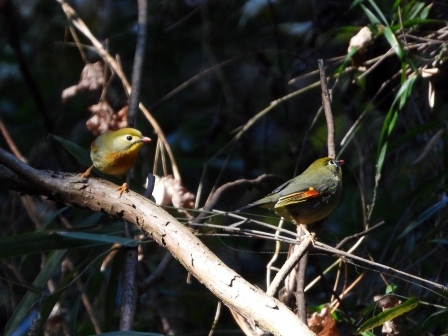
2.イタチが、裏道の小川で見られた。
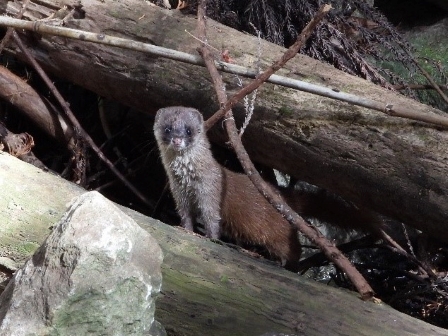
3.2014年12月から6年1カ月にわたり調査を実施してきたが、ここで一区切りにしたいと思います。今後は調査を非定期に実施し、新たな種の確認等が有りましたらご報告いたします。
2020.12.25
ウラギンシジミ
樫の木の葉の裏面にウラギンシジミが止まっていました。名前の通り、翅の裏面が銀色です。成虫は常緑樹の葉の裏面で越冬することが知られており、この個体も越冬すると思われます。
I found a "Uraginshijimi (ウラギンシジミ)" butterfly on the back of a oak leaf. As the name "Uragin" suggests, the back of their wings are actually silver. It is known that they overwinter as an adult on the back of a leaf of evergreen trees, so this one I just saw will probably overwinter there.
2020.12.22
トキワハゼ
校庭の隅でトキワハゼが咲いています。名前のトキワ(常盤)は、一年中花を咲かせることに由来します。よく似た仲間に、ムラサキサギゴケがありますが、ムラサキサギゴケは春に咲きます。
"Tokiwahaze (トキワハゼ)" plants are in bloom in the corner of our school ground. "Tokiwa" in its name means "always" and they are actually in bloom all year around. There is a very similar species that is called "Murasakisagigoke (ムラサキサギゴケ)", but they bloom in spring.
2020.12.18
スギドクガ
ヒノキ林で、鮮やかな緑の毛虫を見つけました。スギドクガの幼虫です。幼虫はスギやヒノキなどを食樹としています。名前にドクガとついていますが、毒はもっていないと言われています。
I found a bright green hairy caterpillar in the Japanese cypress woodland. It is a larva of "Sugidokuga (スギドクガ)" moth. The larvae eat leaves of cedar trees and cypress trees. They are named "Dokuga (ドクガ)", which means "poisonous moth", but they don't actually have poison.
2020.12.15
ニホントビナナフシ(モズのはやにえ)
先週の生物基礎のフィールドワーク中に、ススキ野原でクヌギの枝に刺さったニホントビナナフシを見つけました。モズのはやにえと考えられます。モズのはやにえとは、野鳥のモズが捕らえた獲物をすぐに食べず、木の枝などに刺しておいたものです。はやにえのはたらきは諸説ありますが、最近の研究によると、繁殖期前にはやにえを食べることで、オスの歌の質が高まり、より強くメスを引き付けることがわかったそうです。
We found a stick bug called "Nihon Tobinanafushi(ニホントビナナフシ)", which was impaled on a twig of a SawTooth oak tree during our fieldwork in Basic Biology class last week. It seemed a prey impaled by a Bull-headed Shrike bird, called "Mozunohayanie (モズのはやにえ)" in Japanese. Bull-headed Shrike birds have a custom that they catch a prey and impale it on a twig for their later consumption. There are some hypotheses why they do so. According to a recent study, they eat impaled preys before their breeding period so that they can sing better and attract females more.
2020.12.11
ハキダメギク
校庭の隅でハキダメギクが咲いています。名前のハキダメとは掃き溜めのことで、ゴミ捨て場を意味します。実際にそういった場所によく見られたことが由来といわれていますが、ちょっとかわいそうな名前です。
花はキク科らしい頭状花で、中央の黄色い筒状花とそれを囲む5個の白い舌状花からなります。
"Hakidamegiku (ハキダメギク)" plants are in bloom in the corner of our school ground. "Hakidame (ハキダメ)", which is written "掃き溜め" in Japanese, means "garbage dump". It is said they were named as such because they actually grow in such kind of places, very poor flowers!
"Hakidamegiku (ハキダメギク)" plants have flower heads as they are in the same group as chrysanthemums. There are yellow tubular flowers in the center surrounded by five white tongue-shaped flowers.
2020.12.08
マユミ
共生の森で、マユミがピンクの果実をつけていました。これは、生徒たちが植樹した木の一つです。和名は、枝がしなやかなことから、弓をつくる材料として使われたことに由来します。
A "Mayumi (マユミ)" tree is bearing pink fruits in the Kyoseinomori-Forest(共生の森). This is a tree that students planted. "Yumi (ユミ)" in its name means "bow" and it comes from the fact that their branches are so supple that they were used to make bows.


